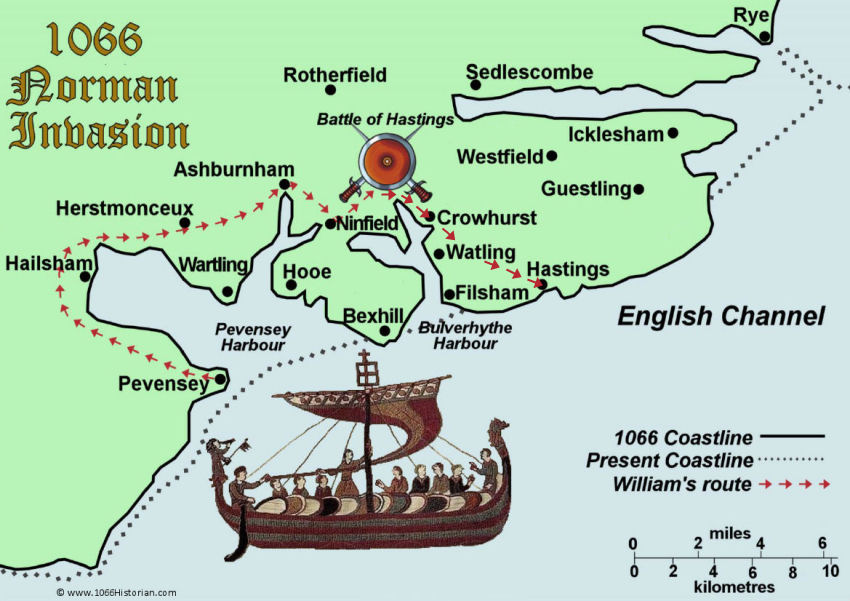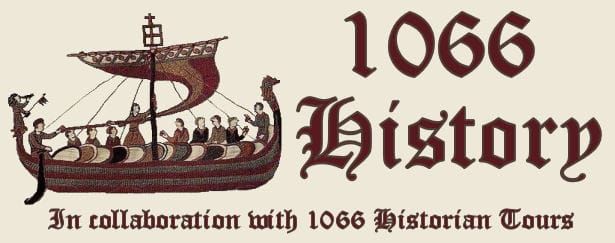William Duke of Normandy believed that when the childless Edward the Confessor died, he would be given the English throne. William’s claim to the throne was through the female line – Edward’s mother, Emma of Normandy, was the sister of William’s grandfather. He also claimed that Harold Godwinson, Edward’s brother-in-law, had sworn on holy relics to support his claim.
William was furious when he learned that Godwinson had been crowned King just one day after Edward’s death and planned his invasion. Although William would make his base at Hastings, he decided to land the bulk of his force at Pevensey while a smaller contingent landed at Bulverhythe harbour.

Why did William land at Pevensey rather than Hastings?
There are a number of reasons why he made this decision:
1. Large Harbour
William had visited England many times and was familiar with the geography of the south coast. He knew that Pevensey was an important seaport with a large harbour that had sufficient mooring for the bulk of his fleet. This meant that he could easily mount a mass attack to defeat any resistance from the Anglo-Saxons.
2. Roman Fort of Anderida
During the Roman occupation of England, the Romans had built a large fort at Pevensey (Anderida). The site offers natural protection with the sea to the south, harbour to the east and wetlands and marsh to the north. The outer walls of the fort were still standing and William knew that if he could secure the fort it would give him a good defensive base to pursue his conquest of England.
The picture above shows the West Gate of the Roman Fort of Anderida flanked by large stone walls. It is almost certain that the Normans would have left from this gate when they embarked on their march to Hastings.
3. Revenge on Harold Godwinson
William was angry with Harold Godwinson for double-crossing him and taking the throne for himself. Harold owned a large manor house in Crowhurst, north-west of Hastings, and this would have been a prime target for William. The Bayeux tapestry depicts the burning of a large house by Norman soldiers. A woman and child are seen fleeing from the fire. This scene most likely depicts the burning of Godwinson’s manor, while the woman could be his mistress Edith Swanneck and one of their children.
William knew that attacking Harold’s lands and possessions would provoke him to battle, possibly in haste, before being fully ready.
4. Proximity to Hastings
It is almost certain that William intended to make Hastings his base from the outset:
There were good connections between Hastings and London in 1066 (roughly what is now the A21). The Anglo-Saxon army that would challenge his invasion was likely to travel south from London along this route.
William had a large army and horses to feed. He did not bring food with him intending to plunder and pillage food from local inhabitants. The region around Hastings was more densely populated than Pevensey and offered a greater food supply.
The area around Pevensey was marshy and would not be an ideal location for a major battle, particularly as the Normans used horses in battle.
Harold owned large areas of land and a manor house in Crowhurst, by destroying these he would provoke him to battle earlier, possibly before he was fully prepared.
It is unclear whether or not William knew of Hardrada’s invasion and Harold’s march north before he sailed. However, he did anticipate meeting resistance upon landing. Pevensey, with its large harbour and existing Roman fort was a two-day march from Hastings and an ideal initial base. As it happened, William landed unopposed and moved on to Hastings within days of landing.


